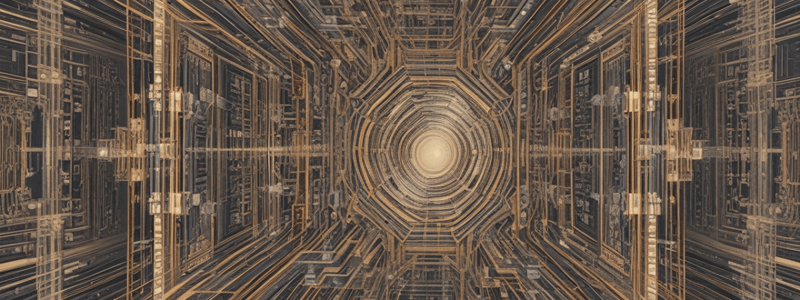Podcast
Questions and Answers
What is the main characteristic of Symmetric Multiprocessors (SMP) that makes them vulnerable to bottleneck?
What is the main characteristic of Symmetric Multiprocessors (SMP) that makes them vulnerable to bottleneck?
The shared centralized memory and bus
What is the primary advantage of using large caches and many buses in Symmetric Multiprocessors (SMP)?
What is the primary advantage of using large caches and many buses in Symmetric Multiprocessors (SMP)?
To reduce memory access latency and avoid bottleneck
What is the key difference between Symmetric Multiprocessors (SMP) and Distributed Shared Memory (DSM) in terms of memory access?
What is the key difference between Symmetric Multiprocessors (SMP) and Distributed Shared Memory (DSM) in terms of memory access?
SMP has uniform memory access (UMA) while DSM has nonuniform memory access (NUMA)
In the context of Distributed Shared Memory (DSM), what is the main challenge in taking advantage of increased memory bandwidth?
In the context of Distributed Shared Memory (DSM), what is the main challenge in taking advantage of increased memory bandwidth?
What is the primary advantage of using OpenMP in parallel programming?
What is the primary advantage of using OpenMP in parallel programming?
In the Fork-Join model, what is the role of the 'fork' phase?
In the Fork-Join model, what is the role of the 'fork' phase?
What is the primary characteristic of MIMD (Multiple Instruction, Multiple Data) systems?
What is the primary characteristic of MIMD (Multiple Instruction, Multiple Data) systems?
How do SMP systems typically address the issue of memory bottleneck?
How do SMP systems typically address the issue of memory bottleneck?
What is the main difference between the communication model of SMP and DSM?
What is the main difference between the communication model of SMP and DSM?
In the context of DSM, what is the primary advantage of using a distributed I/O system?
In the context of DSM, what is the primary advantage of using a distributed I/O system?
Flashcards are hidden until you start studying
Study Notes
Process Creation and Threads
- A process creates a child process (thread) using the fork method, sharing the same address space.
- The process waits for the threads to finish their computation using the join method.
- Creating a process is expensive, so using threads is an alternative.
OpenMP
- OpenMP is an example of Multiple Instruction, Multiple Data (MIMD) Systems.
- Code example in Listing 8.1 demonstrates a simple OpenMP program.
- The code can be compiled and executed to generate four threads.
DSM Communication Model
- In DSM, a distributed memory is used, enabling the message passing model.
- A library project, MPI, implements a message passing interface.
- Explicit communication occurs through message passing, which brings synchronization problems.
Memory Architecture: UMA and NUMA
- In SMP, processors share a single memory with uniform access times (UMA).
- In DSM, processors share the same address space but not the same physical memory, with non-uniform access times (NUMA).
Communication Models
- In SMP, the threads and fork-join model can be used, with implicit communication through memory access.
- In DSM, the message passing model is used, with explicit communication.
Symmetric (Shared-Memory) Multiprocessors - SMP
- SMP are centralized shared-memory multiprocessors with approximately 32 cores or less.
- All processors have equal access to the single centralized memory, with uniform access time (UMA).
- SMP can use large caches and many buses to avoid memory and bus bottlenecks.
Distributed Shared Memory - DSM
- DSM organization uses a larger number of processor cores (e.g., 16-64) with distributed memory.
- Distributed memory increases bandwidth and reduces access latency, but communication among processors becomes more complex.
- DSM has non-uniform memory access (NUMA), with access time dependent on data location in memory.
Studying That Suits You
Use AI to generate personalized quizzes and flashcards to suit your learning preferences.



